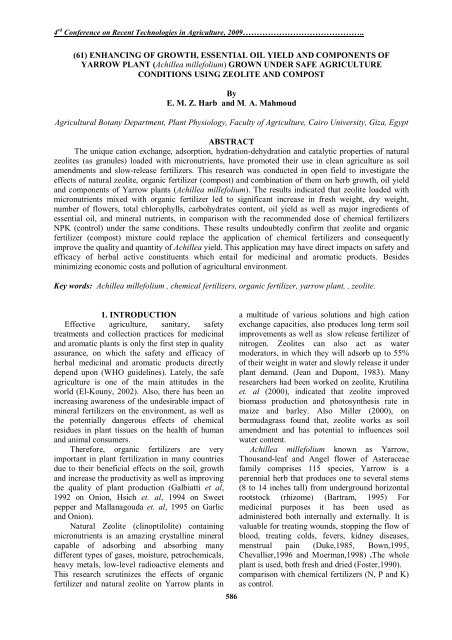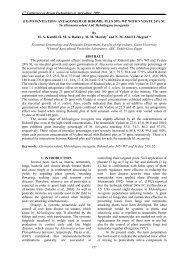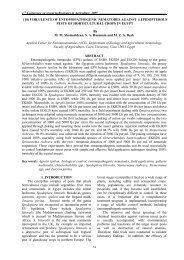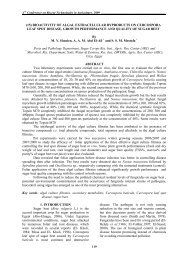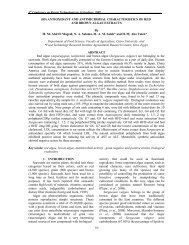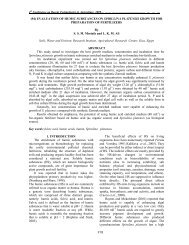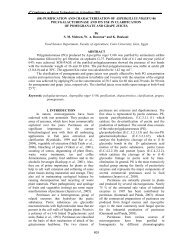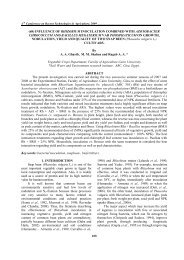ENHANCING OF GROWTH, ESSENTIAL OIL YIELD AND ...
ENHANCING OF GROWTH, ESSENTIAL OIL YIELD AND ...
ENHANCING OF GROWTH, ESSENTIAL OIL YIELD AND ...
You also want an ePaper? Increase the reach of your titles
YUMPU automatically turns print PDFs into web optimized ePapers that Google loves.
d<br />
4 Conference on Recent Technologies in Agriculture, 2009……………………………………..<br />
(61) <strong>ENHANCING</strong> <strong>OF</strong> <strong>GROWTH</strong>, <strong>ESSENTIAL</strong> <strong>OIL</strong> <strong>YIELD</strong> <strong>AND</strong> COMPONENTS <strong>OF</strong><br />
YARROW PLANT (Achillea millefolium) GROWN UNDER SAFE AGRICULTURE<br />
CONDITIONS USING ZEOLITE <strong>AND</strong> COMPOST<br />
By<br />
E. M. Z. Harb and M. A. Mahmoud<br />
Agricultural Botany Department, Plant Physiology, Faculty of Agriculture, Cairo University, Giza, Egypt<br />
ABSTRACT<br />
The unique cation exchange, adsorption, hydration-dehydration and catalytic properties of natural<br />
zeolites (as granules) loaded with micronutrients, have promoted their use in clean agriculture as soil<br />
amendments and slow-release fertilizers. This research was conducted in open field to investigate the<br />
effects of natural zeolite, organic fertilizer (compost) and combination of them on herb growth, oil yield<br />
and components of Yarrow plants (Achillea millefolium). The results indicated that zeolite loaded with<br />
micronutrients mixed with organic fertilizer led to significant increase in fresh weight, dry weight,<br />
number of flowers, total chlorophylls, carbohydrates content, oil yield as well as major ingredients of<br />
essential oil, and mineral nutrients, in comparison with the recommended dose of chemical fertilizers<br />
NPK (control) under the same conditions. These results undoubtedly confirm that zeolite and organic<br />
fertilizer (compost) mixture could replace the application of chemical fertilizers and consequently<br />
improve the quality and quantity of Achillea yield. This application may have direct impacts on safety and<br />
efficacy of herbal active constituents which entail for medicinal and aromatic products. Besides<br />
minimizing economic costs and pollution of agricultural environment.<br />
Key words: Achillea millefolium , chemical fertilizers, organic fertilizer, yarrow plant, , zeolite.<br />
1. INTRODUCTION<br />
Effective agriculture, sanitary, safety<br />
treatments and collection practices for medicinal<br />
and aromatic plants is only the first step in quality<br />
assurance, on which the safety and efficacy of<br />
herbal medicinal and aromatic products directly<br />
depend upon (WHO guidelines). Lately, the safe<br />
agriculture is one of the main attitudes in the<br />
world (El-Kouny, 2002). Also, there has been an<br />
increasing awareness of the undesirable impact of<br />
mineral fertilizers on the environment, as well as<br />
the potentially dangerous effects of chemical<br />
residues in plant tissues on the health of human<br />
and animal consumers.<br />
Therefore, organic fertilizers are very<br />
important in plant fertilization in many countries<br />
due to their beneficial effects on the soil, growth<br />
and increase the productivity as well as improving<br />
the quality of plant production (Galbiatti et al,<br />
1992 on Onion, Hsich et. al, 1994 on Sweet<br />
pepper and Mallanagouda et. al, 1995 on Garlic<br />
and Onion).<br />
Natural Zeolite (clinoptilolite) containing<br />
micronutrients is an amazing crystalline mineral<br />
capable of adsorbing and absorbing many<br />
different types of gases, moisture, petrochemicals,<br />
heavy metals, low-level radioactive elements and<br />
This research scrutinizes the effects of organic<br />
fertilizer and natural zeolite on Yarrow plants in<br />
586<br />
a multitude of various solutions and high cation<br />
exchange capacities, also produces long term soil<br />
improvements as well as slow release fertilizer of<br />
nitrogen. Zeolites can also act as water<br />
moderators, in which they will adsorb up to 55%<br />
of their weight in water and slowly release it under<br />
plant demand. (Jean and Dupont, 1983). Many<br />
researchers had been worked on zeolite, Krutilina<br />
et. al (2000), indicated that zeolite improved<br />
biomass production and photosynthesis rate in<br />
maize and barley. Also Miller (2000), on<br />
bermudagrass found that, zeolite works as soil<br />
amendment and has potential to influences soil<br />
water content.<br />
Achillea millefolium known as Yarrow,<br />
Thousand-leaf and Angel flower of Asteraceae<br />
family comprises 115 species, Yarrow is a<br />
perennial herb that produces one to several stems<br />
(8 to 14 inches tall) from underground horizontal<br />
rootstock (rhizome) (Bartram, 1995) For<br />
medicinal purposes it has been used as<br />
administered both internally and externally. It is<br />
valuable for treating wounds, stopping the flow of<br />
blood, treating colds, fevers, kidney diseases,<br />
menstrual pain (Duke,1985, Bown,1995,<br />
Chevallier,1996 and Moerman,1998) .The whole<br />
plant is used, both fresh and dried (Foster,1990).<br />
comparison with chemical fertilizers (N, P and K)<br />
as control.
Enhancing of growth, essential oil yield and components of………………………………………………….<br />
2. MATERIAL <strong>AND</strong> METHODS<br />
This research was carried out at the<br />
ton/fed. were recorded as mean value of the first<br />
and the second cut for both seasons.<br />
Table (1): Some physical and chemical properties of experimental soil.<br />
Physical properties Cations (me. / l) Anion (me. / l)<br />
Sand (%) 90.5 Ca++ 4.16 CO = 3 0<br />
Silt (%) 6.50 Mg++ 1.52 HCO - 3 0.54<br />
Clay (%) 3.0 Na+ 3.24 Cl - 3.31<br />
Texture grade Sandy K+ 0.21 SO = 4 2.13<br />
pH (soil paste) 7.8<br />
EC (dS/m at 25 °C) 1.37<br />
Total-N (%) 0.03<br />
Organic-C (%) 0.38<br />
experimental farm of Wadi El-Notron, at private<br />
farm (new reclaimed land) as open field, during<br />
two consecutive seasons (2006-2007 and 2007-<br />
2008). Mechanical and chemical analyses of the<br />
soil were performed according to (Richards, 1954<br />
and Jackson, 1973) as shown in (Table1) Also;<br />
chemical characteristics of compost (Table 3),<br />
which obtained from Soil &water and<br />
environment research institute, Agriculture<br />
Research Center (A.R.C) were accomplished as<br />
described by Page et al., (1982) before planting.<br />
Natural zeolite loaded with micronutrients as<br />
granules used in this research was obtained from<br />
Prima Company, Yogyakarta, Indonesia as shown<br />
in (Table 2).<br />
The plantlets of a bout 13 cm. with intact<br />
rhizomes were obtained from experimental farm<br />
of Faculty of Pharmacy, Cairo University, Planted<br />
on the10 th of October (2006) in the Experimental<br />
field, with a distance of 60 cm between rows, and<br />
spacing 50 cm between plants.<br />
Compost at (5 ton / fed.) as well as zeolite<br />
(210 k/fed) and combination of them (1:1) were<br />
added 20 days before planting. Chemical<br />
fertilizers as recommended dose were added at the<br />
rate of 150 k/fed as ammonium nitrate (33%)<br />
divided into two doses, the first was after 3 weeks<br />
from planting and the second was six weeks later,<br />
both Calcium superphosphate (15.5%) at the rate<br />
of 200 k/fed and Potassium sulphate (48%) at the<br />
rate of 50 k/fed were added before planting, The<br />
experiment was performed as a completely<br />
randomized design with four treatments and six<br />
replicates .Agricultural practices were followed as<br />
recommended throughout the growing season.<br />
During the first season on the 20 th of February,<br />
and the 20 th of March (2007) during flowering<br />
stage, plants were cut 10 cm above the soil surface<br />
as the first and the second cut respectively.<br />
Harvest repeated on the 20 th of February, 20 th<br />
March (2008) by the same way. The data of<br />
growth characters, plant height, fresh and dry<br />
weight, number of flowers and fresh weight<br />
587<br />
The mean values of growth characters in both<br />
seasons were subjected statistically analyzed by<br />
using L. S. D. values at 5% level (Gomez and<br />
Gomez, 1984).<br />
Chemical constituents in herb were epresented in<br />
total chlorophylls, carbohydrates content, mineral<br />
nutrients (N, P, K), and oil yield as well as major<br />
ingredients of essential oil.<br />
Total nitrogen was determined by Kjeldah<br />
method described by Bremner and Mulvaney<br />
(1982).Total phosphorus was estimated<br />
colorimetrically as described by Jackson (1973).<br />
The concentration of K was determined by the<br />
Atomic Absorption Spectrophotometer (GBC, 932<br />
AA). Total chlorophylls content was determined<br />
using the method described by Nornai (1982),<br />
while the content of carbohydrates in dried leaves<br />
samples were determined using the method<br />
described by Dubois et al. (1956). Chemical<br />
analysis for essential oil was conducted using the<br />
Ati-Unicam gas liquid chromatography (GLC),<br />
610 series, to determine their main constituents as<br />
described by Gunther and Joseph (1978).<br />
Table (3): Chemical analysis of compost<br />
Property<br />
Value<br />
pH (1:5) 7.5<br />
EC (1: 5 extract) ds/m 3.1<br />
Organic-C % 33.11<br />
Organic matter % 70<br />
Total-N % 1.82<br />
Total-K % 1.25<br />
C/N ratio 14:1<br />
Total-P % 1.29<br />
Fe-ppm 1019<br />
Mn-ppm 111<br />
Cu-ppm 180<br />
Zn-ppm 280<br />
Total content of Bacteria 2.5 x 10 7<br />
Weed seeds 0<br />
Phosphate dissolving<br />
2.5 x 10 6<br />
Bacteria<br />
Humidity (%) 25
d<br />
4 Conference on Recent Technologies in Agriculture, 2009……………………………………..<br />
Table 2. Chemical composition of Zeolite.<br />
Chemical<br />
Composition<br />
%<br />
Trace<br />
elements<br />
P.P.m<br />
SiO 2 TiO 2 Al 2 O 3 Fe 2 O 3 FeO MnO MgO CaO Na 2 O K 2 O SrO P 2 O 3 Loss<br />
on<br />
ignition<br />
45.50 2.81 13.30 5.40 8.31 0.51 6.30 9.52 2.83 0.87 0.22 0.67 3.76<br />
Ba Co Cr Selenium<br />
Cu Zn Zr Nb Ni Rb Y<br />
10 1.2 35 0.8 19 64 257 13 55 15 22<br />
Table (4): Growth characters of Achillea plants as affected by compost, zeolite and<br />
combination of them during 2006- 2007and 2007-2008 seasons.<br />
Herb<br />
Plant<br />
Herb Dry Number Fresh<br />
Seaso<br />
fresh<br />
Treatment<br />
height<br />
weight of flower weight<br />
n<br />
Weight<br />
(cm)<br />
(g/plant) per plant (ton/fed)<br />
(g/plant)<br />
N,P,K (Control)<br />
Compost<br />
Zeolite<br />
Compost+<br />
Zeolite<br />
FS 77.3 d 3072.6 d 950.3<br />
d<br />
SS 82.2 c 3156.7 c 972.2<br />
c<br />
FS 54,2 g 1393.4 h 517.3<br />
h<br />
SS 59.7 f 1506.0 g 546.6<br />
g<br />
12.00<br />
cd<br />
14.00<br />
bc<br />
35.4 d<br />
37.6 c<br />
6.00 e 18.1 g<br />
10.00 d 20.5 f<br />
FS 72,4 e 2110.2 f 728.5 f 11.00 d 28.7 e<br />
SS 78.6 d 2267.4 e 746.6 12.00 29.6 e<br />
e<br />
cd<br />
FS 93.5 b 3320.6 b 1039.7<br />
b<br />
SS 102.3 a 3454.8 a 1087.8<br />
a<br />
15.00 b 40.5 b<br />
22.00 a 45.3 a<br />
Means with the same letter in a column are not significantly different at LSD 5%<br />
F.S: first season S.S: second season<br />
588
Enhancing of growth, essential oil yield and components of………………………………………………….<br />
Table (5): Comparative effects of compost, zeolite and combination of them on nutrient content (N, P, and K),<br />
oil yield, Total Chlorophyll (mg/g fresh weight) and Total carbohydrates (% of dry matter weight)<br />
of Achillea plants during 2006- 2007and 2007-2008 seasons.<br />
Treatment<br />
N,P,K (Control)<br />
Compost<br />
Zeolite<br />
Compost+Zeolite<br />
Season<br />
Total<br />
chlorophylls<br />
Total<br />
carbohydrate<br />
content<br />
FS 2.60 d 21.33 c 1.25<br />
c<br />
SS 2.74 c 24.34 b 1.30<br />
b<br />
FS 2.11 h 16.42 f 1.08<br />
d<br />
SS 2.25 g 18.39 e 1.12<br />
d<br />
FS 2.30 f 19.51 e 1.21<br />
c<br />
SS 2.46 e 20.08 d 1.31<br />
b<br />
FS 3.04 b 23.67 b 1.31<br />
b<br />
SS 3.24 a 26.19 a 1.45<br />
a<br />
N % P % K %<br />
0.28<br />
de<br />
0.37<br />
b<br />
0.18<br />
g<br />
0.22<br />
f<br />
0.26<br />
e<br />
0.31<br />
cd<br />
0.32<br />
c<br />
0.41<br />
a<br />
1.58<br />
d<br />
1.68<br />
c<br />
1.21<br />
f<br />
1.37<br />
e<br />
1.66<br />
c<br />
1.69<br />
c<br />
1.76<br />
b<br />
1.84<br />
a<br />
Means with the same letter in a column are not significantly different at LSD 5%<br />
F.S: first season S.S: second season<br />
Oil yield<br />
(ml/plant)<br />
0.22 c<br />
0.28 b<br />
0.13 e<br />
0.18 d<br />
0.18 d<br />
0.20 cd<br />
0.27 b<br />
0.36 a<br />
Table (6): Effect of compost, Zeolite and combination of them on the essential oil components<br />
of Achillea plants during 2007- 2008.<br />
treatment<br />
Compost+<br />
NPK Compost Zeolite<br />
Zeolite<br />
Components<br />
α-Pinene 6.37 2.48 4.71 9.46<br />
Chamazulene 21.38 16.79 20.11 26.61<br />
Camphor 0.24 0.11 0.18 0.81<br />
β-Pinene 5.67 15.60 11.64 18.47<br />
Limonene 0.61 0.48 0.25 0.95<br />
P-cymene 0.83 0.59 0.18 2.14<br />
1,8-Cineol 2.23 3.47 2.09 4.17<br />
-Caryophllene 9.86 13.07 11.88 15.08<br />
Bornyl acetate 0.40 0.64 0.28 0.78<br />
Cadinene 1.87 0.51 0.99 0.75<br />
α-humulene 1.98 2.66 2.08 3.44<br />
γ-terpinene 3.26 0.79 1.55 1.47<br />
α-Farnesene 2.21 1.86 2.46 1.74<br />
Sabinene 10.51 8.42 5.88 11.59<br />
Total 67.42 67.47 64.28 97.46<br />
589
d<br />
4 Conference on Recent Technologies in Agriculture, 2009……………………………………..<br />
3. RESULTS <strong>AND</strong> DISCUSSION<br />
3.I. Growth characters<br />
The obtained results of plant growth<br />
characters revealed that, compost with Zeolite<br />
mixture treatment significantly increased all<br />
growth characters in both seasons of Achillea<br />
plants compared to the control treatment (plants<br />
receiving the recommended NPK dose) as shown<br />
in (Table,4). The favorable effects of the<br />
combination between compost fertilizer and<br />
Zeolite may be explained based on the beneficial<br />
effects of both of them on the improvement soil<br />
physical and biological properties and also, the<br />
chemical characteristics resulting in more release<br />
of available nutrient elements to be absorbed by<br />
plant root and its effect on the physiological<br />
processes such as photosynthesis activity as well<br />
as the utilization of carbohydrates, in addition to<br />
water use efficiency. These results confirmed by<br />
Pirela, et. al (1984), El-Gahdban et al. (2002) and<br />
Aziz and Iman (2004).<br />
3.2. Chemical analysis<br />
As mentioned of growth characters data, the<br />
results of chemical analysis (Table 5) have the<br />
same conclusion where, all parameters<br />
significantly increased as a result of compost+<br />
zeolite mixture treatment application compared to<br />
control plants. These results are convenience with<br />
those reported by Kallo (1986), El-Gahdban et al.<br />
(2002) and Aziz and Iman (2004).<br />
3.3. Essential oil composition<br />
The results in (Table 6) showed that, the<br />
essential oil of Achillea plants is characterized by<br />
high amount of chamazulene (16.79 - 26.61 %)<br />
from sesquiterpenes as the principal components<br />
of the oil. The highest amount of chamazulene<br />
was increased (26.61 %) with Compost + Zeolite<br />
treatment as compared with the control treatment<br />
(NPK). Also Monoterpene hydrocarbons are an<br />
important group of terpenes, and the major<br />
components were β-Pinene (5.67 – 18.47 %)<br />
which clearly increased (18.47 %) with Compost<br />
+ Zeolite treatment in comparison with (NPK)<br />
treatment, and Sabinene (5.88 -11.59 %), that give<br />
the same trend. Oxygen containing terpenes 1,8-<br />
Cineol (2.09 - 4.17 %) was gave a relative<br />
increment with Compost + Zeolite treatment<br />
compared with (NPK) control .These results are in<br />
agreement with those obtained by several authors,<br />
Hofmann and Fritz (1993), Grth and Czygan<br />
(1999) as well as Aziz and Eman (2004)<br />
4. CONCLUSION<br />
The obtained results in this study are strongly<br />
proved that the mixture of compost and zeolite<br />
was enhanced the growth characters, oil yield and<br />
chemical composition of Achillea plants.<br />
Therefore it could be concluded that, the chemical<br />
fertilizers of NPK could be replaced by the<br />
compost with zeolite mixture for improving the<br />
quality of the produced herb under safe agriculture<br />
conditions, in addition to decreasing the<br />
production costs and environmental pollution.<br />
5. REFERENCES<br />
Aziz and Iman E. (2004). Comparative study on<br />
the Effect of Ammonium Nitrate and<br />
Ammonium Sulphate Through the Application<br />
of Poultry Manure on the Productivity of<br />
Achillea Millefolium L. plants .Arab<br />
Univ.J.Agric.Sci.,Ain<br />
Shams<br />
Univ.,Cairo,12(1),371-389,2004<br />
Bartram T. (1995). Encyclopedia of Herbal<br />
Medicine, 1 st edn.,Grace Publishers,<br />
BournemouthBown D. (1995): Encyclopaedia<br />
of Herbs and their Uses. Dorling Kindersley,<br />
London. ISBN 0-7513-020-31<br />
Bremner J.M. and Mulvaney C.S. (1982).Method<br />
of Soil Analysis. Part2. 2 nd Ed. 595-<br />
624 Agron. Monogr. 9 ASA and SSSA<br />
Madison W.L Chevallier A. (1996). The<br />
Encyclopedia of Medicinal Plants Dorling<br />
Kindersley. London ISBN 9-780751-303148<br />
Dubois M., Smith F., Gilles K. A.., Hamilton J.K.<br />
and Rebers P. A. (1956). Colorimetric Method<br />
for Determination of Sugars and Related<br />
Substances. Anal. Chem., 28 (3): 350-356.<br />
Duke. J. A. and Ayensu. E. S.( 1985). Medicinal<br />
Plants of China Reference Publications, Inc.<br />
ISBN 0-917256-20-4.<br />
El-Gahdban E.A.E., Ghallab A.M. and Abdel-<br />
Wahab A.F. (2002). Effect of Organic<br />
Fertilizer (Biogreen) and Biofertilization on<br />
Growth, Yield and Chemical Composition of<br />
Marjoram Plants Growth under Newly<br />
Reclaimed Soil Conditions. 2nd Congress<br />
of Recent Technologies in Agriculture, Giza,<br />
28- 30 Oct.2002, Vol.(II):pp334-361.<br />
El-Kouny H. M. (2002). Effect of Organic<br />
Fertilizer in Different Aplication Rates Under<br />
Salinity Stress Goudvion on Soil and Plant.<br />
International Symposium and Optimum<br />
Resources Utilization in Salt-Affected<br />
Ecosystems in Arid and Semi-arid Regions, 8-<br />
11 April 2002, Cairo , Egypt, Le Meridian,<br />
Heliopolis Hotel, Abst. Book, pp.33.<br />
Foster S. and Duke J. A. (1990). A Field Guide to<br />
Medicinal Plants. Eastern and Central N.<br />
America. Houghton Mifflin Co. ISBN<br />
0395467225<br />
Galbiatti J.A., Castellane P.D. and Garcia A.<br />
(1992). Effect of irrigation, mineral and<br />
organic fertilization on development and<br />
590
Enhancing of growth, essential oil yield and components of………………………………………………….<br />
productivity of the onion cultivar. Piralones<br />
Ceintifica Jabaticabial, 20 (2-3):371- 378.<br />
Gomez K. A. and Gomez A. A. (1984). Statistical<br />
Procedures for Agricultural Research 2 nd Ed.<br />
International Rice Res. Ins. J. Wiley and Sons<br />
New York, USA pp. 377-434. Grth, M. and F.<br />
Czygan (1999): Variation in Essential Oil<br />
Composition and Chiral Monoterpenes of<br />
Achillea Millefolium . J Essent. Oil Res. 11:<br />
681-688<br />
Gunther Z. and Joseph S. (1978). Handbook<br />
Series in Chromatography. CRC press, Inc.,<br />
New York, USA. Pp. 325-469.<br />
Hofmann L. and D. Fritz (1993). Genetical and<br />
Environmental Caused Variability of the<br />
Essential Oil of Different Types of Achillea<br />
Millefolium lamplex. Acta. Horticulture 330:<br />
147-155.<br />
Hsich C.F., Hsu K., Hsieh C.F. and Hsu K.N.<br />
(1994). Effect of organic manures on the<br />
growth and yield of sweet pepper. Bulletin of<br />
Taiching District Agric. Improvement Station<br />
. 42:1-10.<br />
Jackson M. L. (1973). Soil Chemical Analysis<br />
Prentice-Hall of India private. New Delhi,<br />
pp. 144-197.<br />
Jean-Baptiste Monnier and Dupont M. (1983).<br />
“Zeolite-water close cycle solar<br />
refrigeration ; numerical optimisation and<br />
field-testing”, Proc. Annu. Meet. - Am. Sect.<br />
Int. Sol. Energy Soc. ; Vol/Issue: 6 pp 181–<br />
185; American Solar Energy Society meeting;<br />
1 June Minneapolis, MN, USA<br />
Kallo D., Papp J.and Terbe I. (1986). Horticultural<br />
Use of Zeolite Minerals. Kerteszeti-<br />
Egyetem-Kozlemenyei.50 (18)(1): 47-56<br />
Krutilina V.S., Polyanskaya S.M., Goncharova<br />
N.A. and Letchamo W. (2000). Effects of<br />
zeolite and phosphogypsum on growth,<br />
photosynthesis and uptake of Sr, Ca and Cd<br />
by barley and corn seedlings. Journal-of-<br />
Environmental-Science-and-Health-Part-A,-<br />
Toxic/Hazardous-Substances-and-<br />
Environmental- Engineering. 35(1): 15-29<br />
Mallanagouda B., Suliker G.S., Hulamani N.C.,<br />
Murthy B.G. and Madalgeri B.B. (1995).<br />
Effect of NPK and FYM on growth<br />
parameters of onion, garlic and coriander.<br />
Curent Res. Univ. Agric. Sci. Bamgalore ,<br />
24(11):212-213.<br />
Miller G.L. (2000). Physiological response of<br />
bermudagrass grown in soil amendments<br />
during drought stress. Hort. Science. 35(2):<br />
213-216<br />
Moerman D.(1998). Native American<br />
Ethnobotany Timber Press. Oregon. ISBN 0-<br />
88192-453-9.<br />
Nornai R. (1982). Formula for determination of<br />
chlorophyll pigments extracted with N-Ndimethyl<br />
formamide . Plant Physiology,<br />
69:1371-1381.<br />
Page A. I., Miller R. H. and Keeney T. R. (1982).<br />
Methods of Soil Analysis part 2 Amer. Soc.<br />
Agr. Inc. Madison WI9:595.<br />
Pirela H.J., Westfall D.G. and Barbarick K.A.<br />
(1984). Use of Clinoptilolite in Combination<br />
with Nitrogen Fertilization to Increase Plant<br />
Growth. Zeo-Agriculture:-Use- of-naturalzeolites-in-agriculture-and-aquaculture.<br />
113-<br />
122<br />
Richards L.S.(1954). Diagnosis and Improvement<br />
of Saline and Alkaline Soils. U.S. Dept. Agric.<br />
Handbook No.60<br />
WHO Guidelines (2003). on Good Agricultural<br />
and Collection Practices (GACP) for<br />
Medicinal Plants .<br />
591
d<br />
4 Conference on Recent Technologies in Agriculture, 2009……………………………………..<br />
تحسين النمو ومحصول الزيت ومكوناته فى نباتات الأشيليا النامية تحت ظروف الزراعة النظيفة باستخدام السماد<br />
العضوى والزيوليت<br />
أ.د إجلال زكى محمد حرب -محمد عبد الوهاب محمود<br />
فرع فسيولوجى النبات ،قسم النبات الزراعى ،كلية الزراعة<br />
،<br />
.<br />
.<br />
جامعة القاهرة<br />
ملخص<br />
تم الأستفادة من الصفات الطبيعية والكيماوية لمادة الزيوليت(حبيبات) المحملة بالعناصر الصغرى لما لها من<br />
المقدرة العالية على التبادل الكاتيونى والادمصاص والامتصاص وخواص التحفيز الكيميائية وكذلك القدرة على نزع<br />
وإضافة جزيئات الماء بالإضافة الى كونه سماد بطيىء التحلل ومحسن لخواص التربة فى اجراء هذا البحث والذى تم فيه<br />
دراسة تاثير الكومبست والزيوليت وخليط منهما في الحقل على محصول العشب والزيت ومكوناته لنباتات الأشيليا، حيث<br />
أظهرت النتائج أن خلط الكومبوست مع الزيوليت المحمل بالعناصر الصغرى أدى إلى زيادة معنوية فى الصفات<br />
المورفولوجية المتمثلة فى الوزن الطازج والوزن الجاف وعدد النورات للنبات الواحد وكذلك الصفات الكيميائية المتمثلة فى<br />
زيادة محتوى الصبغات والكربوهيدرات والعناصر المعدنية بالإضافة الى محصول الزيت ومكوناته الرئيسية، وذلك<br />
بالمقارنة بالتسميد الكيماوى تحت نفس الظروف هذه النتائج تؤكد على ان خلط الزيوليت مع الكومبست يمكن ان يحل<br />
محل التسميد الكيماوي وزيادة جودة محصول الاشيليا كما ونوعا وهذا التطبيق بدوره له تاثير مباشر على السلامة وزيادة<br />
كفاءة المواد الفعالة وهو الامر المطلوب فى المنتجات الطبية والعطرية بجانب إمكانية الإقلال من التكاليف الإقتصادية<br />
وتلوث البيئة الزراعية<br />
592


